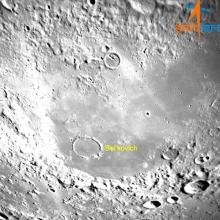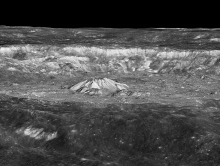Listen to today's episode of StarDate on the web the same day it airs in high-quality streaming audio without any extra ads or announcements. Choose a $8 one-month pass, or listen every day for a year for just $30.
You are here
Moon and Regulus
The Leonid meteor shower is beginning its annual display in the night sky. It’ll peak in the middle of next week. The Moon won’t be in view then, so the meteor watching will be especially good.
The Moon is around for a few nights before then, though, and a telescope in Greece will keep an eye on it. In particular, it’s looking for impacts by space rocks, whether they’re from the stream of debris that forms the Leonids or not.
The project was established by the European Space Agency, using a refurbished telescope in Greece. The telescope monitors the dark portion of the Moon when the Moon is less than half full. It’s looking for short flashes of light caused when space rocks hit the surface. Although it’s mainly looking for impacts by larger space rocks, the telescope’s mirror is big enough to detect the impacts of rocks that weigh as little as a few grams.
Counting the number of flashes will help the space agency plan future missions to the Moon — it’ll have a better idea of the risks from impacts. The numbers also will reveal how many rocks are hitting Earth, which can help engineers better protect spacecraft in orbit.
The project started in March, and will continue through the end of next year.
And while we may not see many meteors through the moonlight tonight, the Moon does have a bright companion: Regulus, the brightest star of Leo. It rises to the lower left of the Moon late tonight, and stands closer to the Moon at dawn tomorrow.
Script by Damond Benningfield






